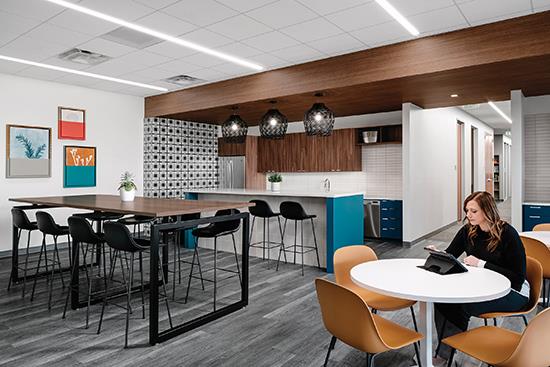The Top 250 Design Survey 2021: Designers report that conditions are improving in many commercial sectors - Oct 2021
By Darius Helm
Last year, the pandemic put the brakes on the commercial market in early spring-for calendar year 2020, commercial flooring sales were down by around 20%-with some sectors hit harder than others, but all impacted to some degree. This year, designers report higher activity across much of the commercial market, and more importantly, forward-looking indicators point to a surge in business in 2022.
Supply chain issues continue to dog both the new construction and renovation markets, and in some cases have worsened. Early on, production of components, raw materials and finished goods was significantly constrained. But now, even if there’s product, there no way to get it in a timely fashion because of transportation issues-bottlenecks at ports worldwide and trucking issues here in the U.S.
And when it comes to putting together commercial interiors or constructing new buildings, every component is necessary and has a place in the order, so a single issue can grind the whole process to a halt.
Nevertheless, the commercial market is resilient, demand is high in many sectors, and business is picking up. In early 2020, the American Institute of Architects’ Architecture Billings Index, which generally indicates activity levels nine months to a year down the road, fell under 50 after five months in positive territory-above 50 indicates an increase in billings, and below 50 is a decrease-and plunged to 29.5 in April. It finally made it back into positive territory in February of this year, reached a high of 58.5 in May and by July had settled back to a healthy and dynamic 54.6.
It’s also worth noting that even when the market falls by 20% or so, there’s still a ton of business being done-80% is still 80%. Many designers remain busy, facing many of the same issues of working with end users, reps and contract dealers, securing the materials they need in the specified colors, patterns and construction, and building out new spaces.
Compared to last year-when only 3% of respondents said budgets were up, 50% said they were down and 47% said they were flat-this year has rebounded: 32% say budgets are up, 30% say they’re down and 38% say they’re unchanged.
SECTOR OVERVIEW
In terms of the sectors that have shown the most growth in the last 18 months, most respondents still cited medical/acute care, topping the list for the third year in a row though with a third fewer votes than last year (turn to page 55 for an in-depth report on acute care activity). The K-12 education sector and the multifamily sector also received fewer votes but stayed in the top three markets.
One of the big gainers in the last 18 months has been the single-family residential market-higher-end homes, obviously, since they’re being custom designed by A&D. This likely reflects the movement out of some cities during the early months of Covid, like in the New York metro area.
Votes for government as the fastest-growing sector more than tripled in this year’s survey. Government always rises up the list when there’s an incoming administration.
Also up were votes for retail, to 4% from 0% last year. Some of this probably comes from retail stores renovating their spaces in response to needs for germ-free cleanliness and social distancing, along with some turnover from retailers going out of business and new ones moving in. And senior living projects were also up, possibly for similar reasons.
Floor Focus also asked designers about the market sectors for their three biggest recent projects. Corporate jobs topped the list, but with far fewer votes, with large and medium corporate jobs down by almost half and Fortune 500 jobs down marginally. In education, small gains in large K-12 projects were erased by fewer large university jobs.
Healthcare actually made slight gains due to an increase in senior living projects, with medical office building and acute care projects staying flat.
Large retail projects jumped four-fold, though from a small base-from 1% in 2020 to 5% this year-and there were also modest gains in hospitality, public space and higher-end residential.
Designers were also asked about the performance of carpet tile, the largest flooring category in the commercial market, across the various sectors. As always, corporate, which is by far the largest commercial sector, accounted for most carpet tile use, though votes were down from 59% in 2020 to 44% this year, reflecting conditions in that sector. Carpet tile was also down in the tenant improvement side of the corporate market. Both corporate and tenant improvement were down about 25% in votes.
The most significant gains for carpet tile over the last year have come from the multifamily, medical/acute care and hospitality segments, three sectors that are traditionally relatively stronger in broadloom-though, like all sectors, carpet tile has been taking share for many years. Also, carpet tile is an easier install than broadloom, requiring a smaller team, which could have given the category a leg-up during the pandemic.
For the complete Design Survey results, see the October 2021 issue of Floor Focus Magazine.
Copyright 2021 Floor Focus
Related Topics:The American Institute of Architects
